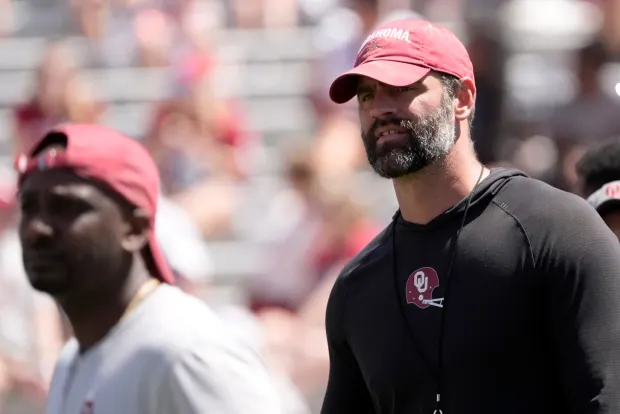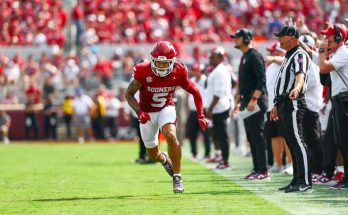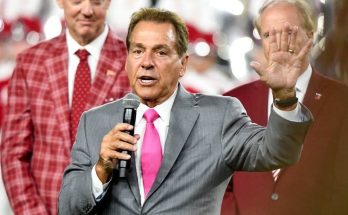In a surprising development that has sent ripples through the Oklahoma football community, the Sooners have officially lost out on a coveted 2026 family legacy recruit—one who many believed was destined to wear the crimson and cream. Instead, the rising star opted to commit to another Big 12 program, spurning the family ties and the rich legacy associated with Norman in favor of a growing pipeline and an opportunity for early impact. For the Sooners, it’s more than just a recruiting miss—it’s a wake-up call that shines an unrelenting spotlight on a position group that has struggled to keep up with the demands of championship-level football.
The player in question, a highly touted prospect and son of a former Oklahoma standout, had been on the radar of Brent Venables and his staff since middle school. His name has long been associated with Oklahoma football circles, with fans eagerly anticipating the continuation of a bloodline that had once helped shape the program’s success. Yet when the decision came, the Sooners found themselves on the outside looking in, watching a familiar name commit to a conference rival—one that has become a modern-day disruptor in Big 12 recruiting.
For Oklahoma fans, the loss stings in multiple dimensions. The emotional blow of losing a family legacy—a player who grew up attending games at Gaylord Family – Oklahoma Memorial Stadium, who wore OU gear before he could walk—is compounded by the growing narrative that the Sooners are slipping in certain areas of positional development. This wasn’t just a recruit. This was supposed to be a cornerstone. Instead, his commitment elsewhere adds to the perception that Oklahoma is struggling to build elite depth at a key position that has become increasingly vital in both the college and professional game.
What makes the situation even more frustrating for Oklahoma is the fact that this wasn’t a matter of geographic distance or lack of opportunity. The Sooners offered early, rolled out the red carpet on official visits, and made every effort to reinforce the family connection. Yet, in the end, it wasn’t enough. The recruit cited his desire to forge his own path, to play in a system better suited to his skillset, and to be part of a rising program where he could contribute from day one. His decision underscores an evolving reality in college football recruiting: legacy and tradition, while valuable, are no longer enough in a landscape dominated by NIL deals, early playing time, development pipelines, and systems that cater specifically to positional strengths.
This loss also forces Oklahoma to confront a hard truth: their current depth and outlook at the position group in question—whether it be cornerback, linebacker, wide receiver, or offensive line—is not instilling confidence in top-tier talent. While Brent Venables has made strides in recruiting and defensive structure since taking over, there remain areas on the roster that appear thin, inconsistent, or flat-out underwhelming in comparison to rivals across the Big 12 and future SEC opponents. And when a position group appears weak, it becomes a glaring red flag for high school players looking to join a room that offers competition, development, and a clear path to the league.
This was supposed to be the class where Oklahoma made a strong, definitive statement. The move to the SEC looms, and with it, the need for elite talent across every layer of the roster has never been greater. That’s why the Sooners placed such an emphasis on the 2026 cycle, especially for legacy targets—players who, in years past, might have committed early out of loyalty or tradition. The failure to land this recruit could be viewed as symbolic of a broader issue: a gap between the program’s historical perception and its current trajectory. Recruits today are making decisions based on the present, not the past. And right now, there are question marks at Oklahoma that even legacy ties can’t cover up.
Complicating matters is the strength of the Big 12 pipeline that won this recruiting battle. The program that secured the legacy player has built a strong foundation of player development, NIL infrastructure, and positional focus that has become increasingly attractive to elite recruits. Their message is simple: come here, and you’ll play. You’ll develop. You’ll win. For this particular recruit, that message resonated more powerfully than any family tradition ever could. And for Oklahoma, that should raise alarms—not just among fans, but inside the walls of the football facility.
Losing a legacy recruit always brings optics issues. It creates a media storyline that’s difficult to spin. But more importantly, it can create a ripple effect in recruiting circles. Other prospects take notice. They begin to question why a player so closely tied to a school would walk away. They wonder about the coaching staff, the depth chart, the scheme fit, and the program’s direction. In the high-stakes world of elite recruiting, perception often becomes reality, and this miss may very well be used by rival schools as ammunition in future battles.
Now the pressure mounts on Brent Venables and his staff to respond—and respond decisively. The Sooners must identify and pursue alternate targets with the same vigor, while simultaneously reassessing their approach to development at the weak position group that just cost them a major piece of the 2026 puzzle. This is not a moment for panic, but it is certainly a moment for introspection and strategic recalibration.
One area that needs immediate attention is the development track within the position room. Recruits are watching closely to see how young players progress once they get to campus. Are they getting better? Are they seeing the field? Are they being prepared for the next level? In the case of Oklahoma’s position group in question, those answers have been mixed at best over the last two seasons. Whether due to inconsistent coaching, lack of competition, or player stagnation, the results haven’t matched the expectations that come with the Sooners’ brand.
There’s also the issue of NIL—a critical component in modern recruiting that cannot be ignored. While Oklahoma has made strides in establishing collectives and partnerships, the competitive edge in NIL battles remains uneven across different position groups and recruits. The Big 12 school that secured this commitment has been aggressive and efficient in leveraging NIL opportunities for top targets, and that aggressiveness played a clear role in this particular decision. If Oklahoma wants to compete at the highest levels of recruiting, their NIL efforts must not only match—but exceed—those of their peers.
And then there’s the coaching component. Position coaches play a massive role in recruiting and development. They are the face of the room, the architects of growth, and the voices recruits and parents trust. If there’s even a hint of disconnect, instability, or misalignment in coaching philosophy, elite players will go elsewhere. Oklahoma must ensure that their staff not only connects with top prospects but inspires confidence that this is the place to thrive—both on Saturdays and in preparation for Sundays.



